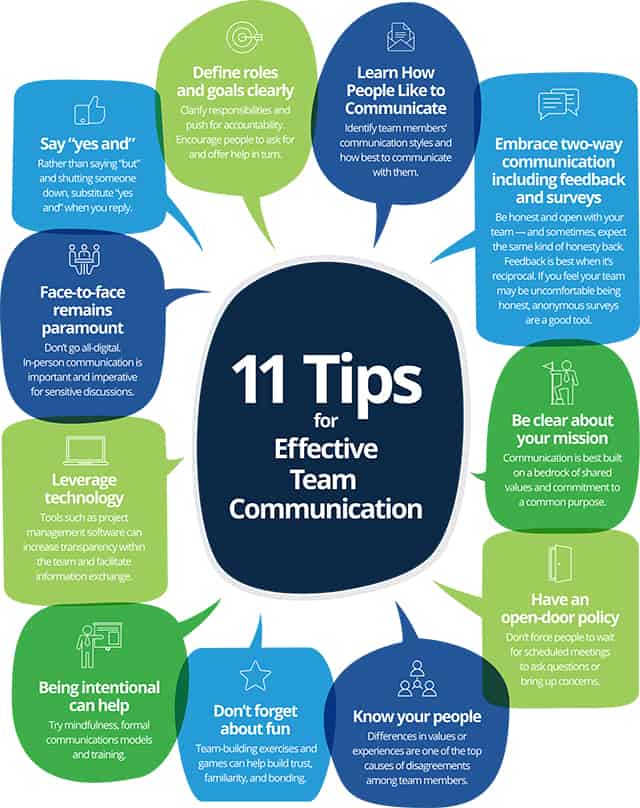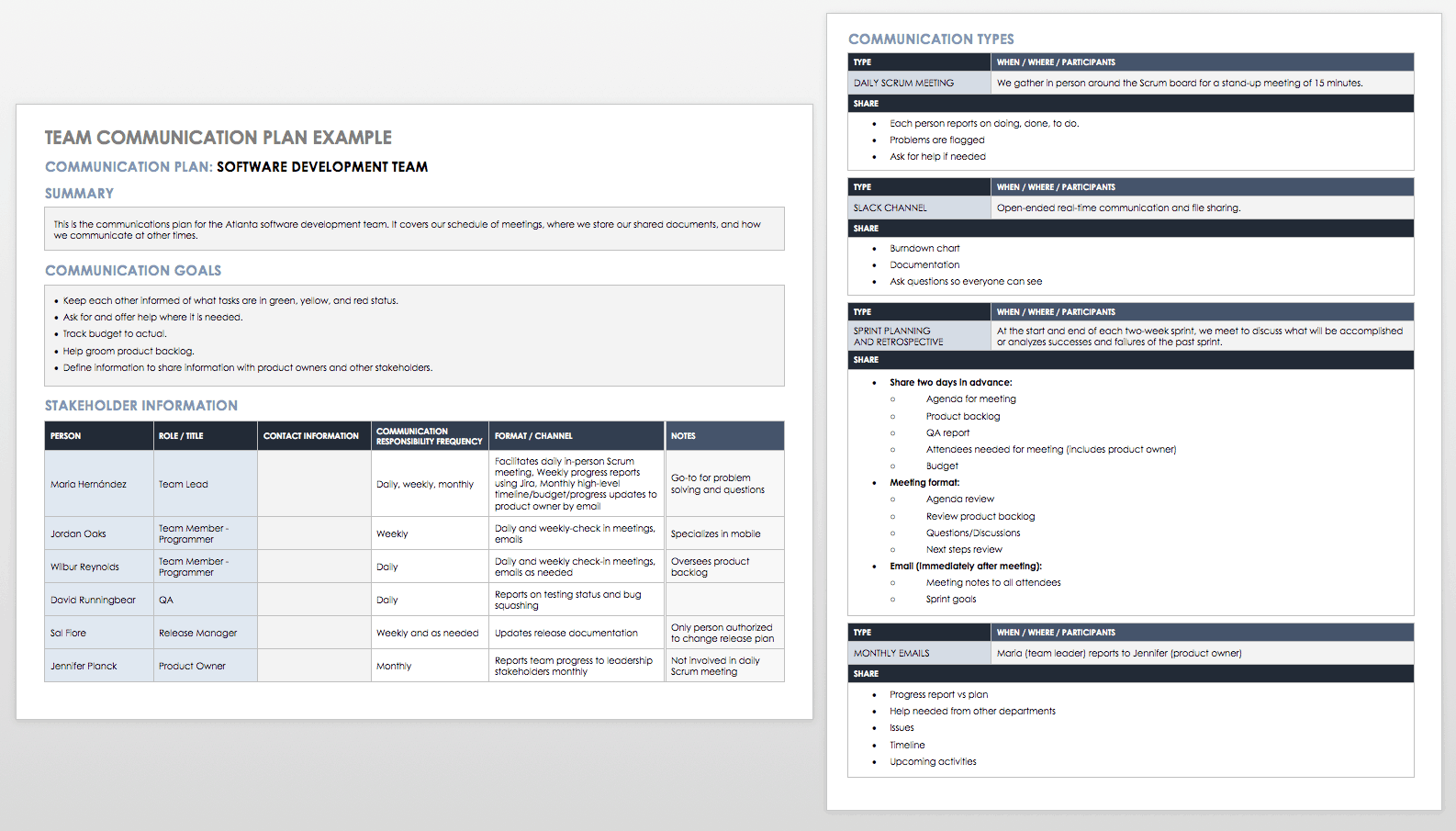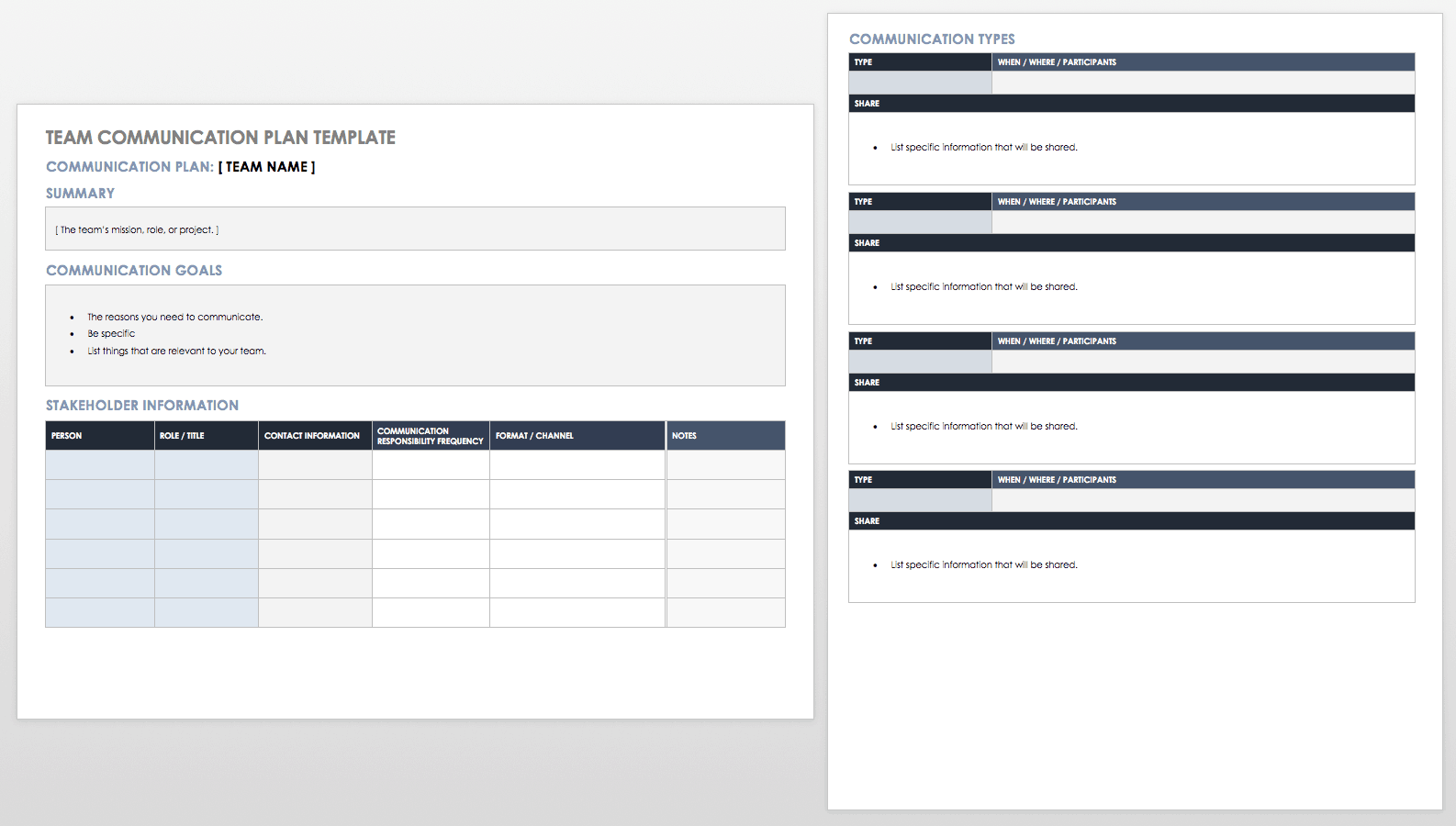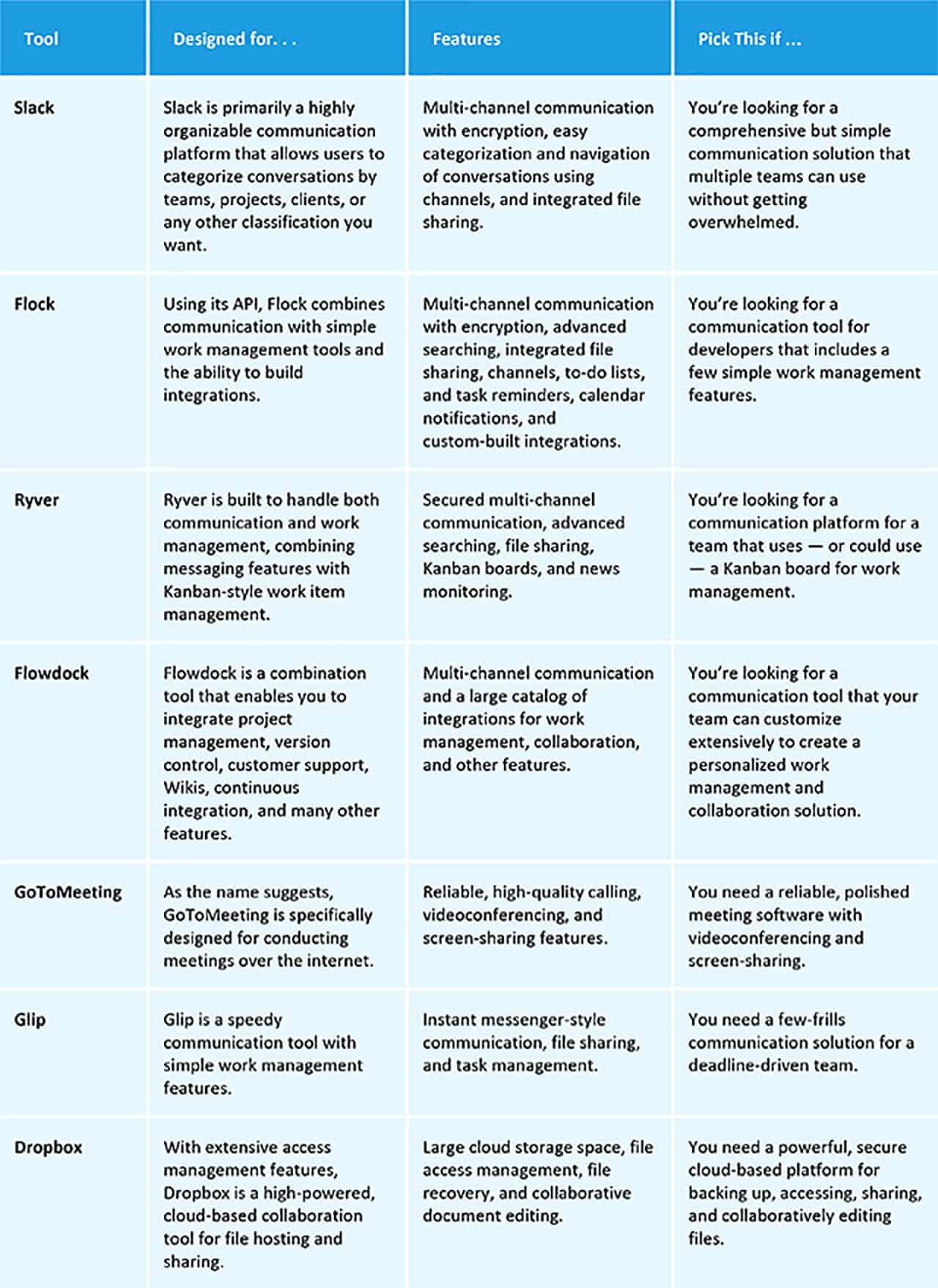What Is Team Communication?
Team communication encompasses all the interactions among members of a work team or group. These interactions include all the conversations we have with colleagues: face-to-face, in writing, and electronically via email, phone, video, and other media.
Communication isn’t just about the spoken word itself; it also concerns intonation, modulation, volume, and other cues. A branch of linguistics known as pragmatics studies how context adds meaning to conversation, even our “ums” and “ahs.”
Team communication includes the nonverbal ways (i.e., facial expressions, hand gestures, and body language) in which we convey attitudes and feelings. There are three broad categories of communication:
- Face-to-Face Communication: This happens between people who are in the same place at the same time.
- Synchronous Communication: This happens when two people are carrying on a conversation in real time despite being in different locations (i.e., a phone call).
- Asynchronous Communication: This occurs when people in different locations contribute to a conversation with delayed responses, such as with email.
Teamwork is important in all industries, and team communication is a critical component in building strong teams. Strong communication paves the way for achieving shared goals.
How Does Communication Affect a Team?
A team’s success hinges on its ability to communicate well, regardless of the industry or mission. Collaboration, the division of duties, the sharing of vision, and the exchange of information all require good communication. Teams can do more than individuals — except if communication is weak or breaks down.
In fact, Alex Pentland, a legendary computer scientist at MIT who studies human dynamics, has found patterns of communication to be the strongest predictor of a team’s success — as significant as the following factors combined: individual intelligence, personality, skill, and the substance of team discussions.
So, how do you build a team that communicates effectively? You should understand what good communication looks like, build a strong framework to support it and model it, and pick the right tools to facilitate it. Let’s look at each of these elements.
The Different Forms of Team Communication
We can understand the fundamentals better by differentiating between the “what” and “who” of team communication.
The “what” of communication is the mode or medium (i.e., verbal or nonverbal, paper or electronic, words or images, or audio or video). The “who” of communication concerns both the number of participants and each participant’s standing within the team.
Here are the three types of team communication:
- Top-Down Communication: This is when a high-ranking member of a team contacts a lower-ranking one. Downward communication is the most likely to be prescriptive.
- Bottom-Up Communication: This is when the flow of contact moves in the opposite direction. Bottom-up communication is most often suggestive.
- Peer-to-Peer Communication: This is when contact takes place between team members of equal rank. Peer-to-peer communication tends to consist of discussion.
In any of these directions, communication may either be one-on-one or involve small to medium-sized groups.
We should note that we are focusing on internal or intra-team communication. External communication happens between teams, with organizational authorities to whom the team reports, with other stakeholders, such as the workforce or shareholders, or with outside constituents, such as customers.
Why Communication Is Important in a Team
To get a vivid idea of why good communication is so crucial, think about the results of poor communication: misunderstandings, arguments, missed deadlines, unachieved goals, stress. Wouldn’t it be great if there were a way to avoid these negative outcomes?
A team that doesn’t communicate well is like a poorly lubricated engine. At best, it’s a source of productivity-reducing friction. At worst, it results in project paralysis and a virus of blame.
But, when communication flows, it becomes the glue that holds a team together. Good communication does the following:
- Helps teammates trust each other
- Builds a sense of belonging and team loyalty
- Ensures staff have the information needed to do their jobs well
- Creates an environment where people feel respected, secure, and engaged
- Supports synergy (i.e., teamwork that exceeds the sum of individual contributions)
- Promotes creativity and innovation through the exchange of ideas
- Reduces and diffuses conflict
- Improves staff motivation and retention
- Leads employees to speak positively about the organization
Highly engaged staff members are deeply invested in the company’s mission, and high engagement is closely correlated with organization outperformance and higher levels of staff retention, according to research from consultancy Aon.
In Pentland’s studies that looked at communication on a bank’s call center teams, team energy and engagement levels outside meetings predicted one third of the variance in dollar productivity among groups. Differences in communication success among seemingly identical teams produced widely varying performances.
An earlier study at Carnegie Mellon University that examined communication among students participating in a business competition found that more highly coordinated teams performed better both in the stock market and in board evaluations.
What Are the Signs of Good Communication?
The outcomes of effective communication practices is easy to spot: Projects are completed successfully and on schedule, since everyone knows what they’re doing; intra-team communication is open, professional, and cordial; and people aren’t afraid to ask questions or answer them.
But, these improvements only describe the results of good communication. What does good communication look like in action?
There are two ways to answer this question: by looking at communication at the individual level and at the team level.
At the individual level, the natural communicator displays a number of consistent and predictable behaviors:
- Though not necessarily extroverts, natural communicators are not shy about approaching other people.
- In packed rooms, they will actively circulate, participating in short but dynamic conversations.
- In doing this, they explore new ideas and contacts that the team can harness and utilize.
- This sharing of ideas has a knock-on effect, since the communicator then circulates these ideas to many different people, who pass them on to other people, and so on.
- Natural communicators are not selfish talkers who seek mainly to monopolize conversations. They listen at least as much as they talk, and they’re usually highly engaged and focused listeners.
- They treat teammates equally, giving everyone a chance to hear and be heard.
- They actively solicit opinions from teammates who are less forthcoming.
Good communication also has some distinct hallmarks at the team level:
- Team members talk and listen in turn, instead of allowing a few teammates to monopolize the conversation.
- Communication is multi-directional: not just from the top down, but from the bottom up and peer to peer as well.
- The team does not remain insulated. Members go outside the team to retrieve information, obtain resources, and forge contacts.
- Good communication is evident from body language: Team members face each other when they talk and use expressions and gestures to make their point.
- A team that communicates well will deliver feedback openly and honestly.
- Teammates share core values and have the same goals so they communicate from a shared context and baseline.
- Situational leadership is more common. This is a flexible leadership style that adapts to the needs, goals, and maturity of the team and often excels in building rapport and bringing out the best in team members.
Pentland’s work at the Human Dynamics Laboratory at MIT has found that three aspects of communication predict team performance: energy, engagement, and exploration.
- Energy: This is measured by the number and nature of exchanges that team members participate in.
- Engagement: This shows how energy is distributed within a team; teams in which energy is both high and evenly distributed have high engagement.
- Exploration: This measures engagement with people outside of the group when team members gather information and acquire resources. Engagement and exploration tend to be inversely proportional, since they’re both time and energy-consuming processes.
Teams with high engagement and high energy were the most efficient performers in Pentland’s studies. But in a more unexpected finding, teams with low energy and low engagement tend to perform better than teams that are unbalanced — those that have high energy but low engagement, or vice versa. This suggests that simply having a high number of interactions is not sufficient; the interactions must involve most, if not all, of the teammates.
Pentland also found that the simple quantity of face-to-face exchanges between team members predicts over a third of the variance in performance among similar teams. Yet, more exchanges are not necessarily better. Exceeding an ideal threshold for the number of exchanges — typically some dozens of exchanges per working hour — is actually detrimental to performance. Social time among teammates is “deeply critical” to team performance, Pentland found, accounting for more than half of the positive change in communication patterns.
Obstacles to Good Team Communication
Communication is a process that, like any other, can be disrupted or blocked. Impediments to effective communication are varied, some obvious and some not.
- Physical Barriers: These include spaces that are not conducive to conversation because they are noisy, have an awkward layout, or are too small (or even too large). Remote teams and seating arrangements that place people far apart can interfere with communication, as can having a boss who sits separately.
- Too Much Togetherness: Ironically, a lack of privacy and frequent interruptions can also interfere with the quality of communication. Researcher Gemma Irving from the University of Queensland found that open-plan offices work best for teams where members interact frequently on connected tasks and share information in many short exchances. Long conversations are best held in private spaces because people feel more willing to talk at length when they are not overheard, she found.
- Language and Cultural Barriers: These are obvious communication blockers and stand in the way of team bonding and trust.
-
Size of Group: Opinions vary widely on the optimal number of members, but clearly having too many or too few people on the team is not helpful. Most research seems to settle on four to five as the ideal number, with one influential study favoring seven.
-
Interpersonal Conflict: Conflict isn’t bad per se, especially if it is handled respectfully and opens key questions about the team’s work for discussion. But conflict born of personality clashes, power struggles, or dysfunctional behavior styles can chill team communication. Embedding good communication from the start can preempt some of these problems from blossoming.
-
Failure to Transmit Team Knowledge: Good communication is hard if people don't operate from a shared baseline. This can be a problem especially if there is turnover on a team and newcomers do not know the history of team successes and failures. In 2000, researchers from the University of St. Gallen in Switzerland proposed a comprehensive five-layer model for managing team knowledge.
When to Reset Your Communication Framework
Do new members of your team seem to struggle with mastering your communication methods? Are you spending too much time getting everyone on the same page, or does your team suffer frequent misunderstandings?
If so, your communications strategy may benefit from a reset. Ask yourself the following questions. If you see a lot of room for improvement, it is time to rethink your communications approach.
- Does everyone know exactly what everyone else does?
- Does everyone understand your language, terms, and jargon?
- Are there clear and established ways for communication from outside the team to be relayed to the group?
- Are shared resources easy to locate and access?
- If you use more than one communication channel, does everyone understand which one to use when?
- Do people feel comfortable being honest and participating in discussions?
Best Practices for Effective Communication on Teams
While effective communication styles are flexible and adapt to the situation, some best practices have emerged. These rules are best used as guidelines to be modeled and encouraged, not enforced.
The key practices fall into three categories: people, conversation, and messaging.
People Rules:
- Everyone Takes Part: Team members contribute, not just to the work but to discussions as well. When it’s only a few people doing all the talking, communication is not effective. Truly effective communication is 360 degrees.
- Everyone Gets Heard: The corollary to everyone taking part in a conversation is that everyone needs to listen as well.
- Everyone Is Respected: Follow the first two rules, and the third becomes a cinch. When people see that their contributions are valued, they’re happier, and their engagement with the team and commitment to its goals increases.
- Everyone Knows Everyone: Or, at least they try to, a little bit at a time. This rule isn’t about knowing one’s teammates personally — though that can help. Rather, it’s about getting to know their strengths and weaknesses, their motivations, and their perspectives.
Conversation Rules:
- Ask Questions: Nobody should ever feel bad about asking a question when they don’t fully understand. Asking questions helps everyone clarify mutual understanding and improves team alignment.
- Check to Make Sure Everyone Understands: The speaker has a duty to confirm that everyone has grasped the message. Leave time for questions and don’t make teammates feel dumb when they ask for clarification.
- Realize That Not Everyone Will Get It Right Away: Despite best efforts, not everyone walks away with the intended message immediately. This makes following up and reinforcing important.
Message Rules:
- Keep It Short: Be succinct. This makes your takeaways more memorable, saves time, and prevents one or two teammates monopolizing the discourse.
- Summarize and Follow up: Recap and reiterate your message multiple times when you deliver it and then afterward too. Follow ups should be concise. Use a consistent format for follow-ups.
- Choose Your Channels Carefully: Pick a central channel for communication and make sure everyone knows what it is. Things fall through the cracks if people have to juggle too many platforms. We will go into detail later on choosing the right channels and tools.
Experts’ Top Tips: How Can You Improve Communication in a Team?
In this section, you’ll find experienced team leaders’ and consultants’ best insights into how to improve team communication. You can also download a printable and shareable version here .
1. Define Roles and Goals Clearly: Let people know what they’re in charge of. Clarifying responsibilities and pushing for accountability gives everyone a way to slot into the team. Responsibilities, of course, should be assigned and undertaken based on individual strengths, which is why it’s so important for team leads to know the people under their command. Encourage people to ask for and offer help in turn. This makes communication more purposeful and increases productivity. And yet it’s important to remember that when mistakes happen, taking ownership for them collectively — instead of looking for scapegoats — increases trust in the team.
2. Learn How People Like to Communicate:
3. Embrace Two-Way Communication, including Feedback and Surveys: As a team lead, be honest and open with your team — and sometimes, expect the same kind of honesty back. Feedback is best when it’s reciprocal.
4. Be Clear about Your Mission: Communication is best built on a bedrock of shared values and commitment to a common purpose.
5. Have an Open-Door Policy:
6. Know Your People:
7. Don’t Forget about Fun: Exercises and games can help build trust, familiarity, morale, and bonding. Check out this article for lots of ideas and this tool for finding the right activity for your team. If your team doesn’t take to the idea of playing games, remember that there are viable alternatives, such as longer lunch breaks and hobby groups, which achieve the same purpose: getting people to talk outside of a purely professional sphere.
8. Being Intentional Can Help:
9. Leverage Technology: Tools such as project management software can increase transparency within the team, and the McKinsey Global Institute found that the average staff member, who spends more than a quarter of the workweek managing email and a fifth tracking down specific information or human resources, can reduce the time they spend searching for information by over a third if their company uses social media internally.
10. Face-to-Face Remains Paramount: While digital communication is handy and efficient, face-to-face communication is still needed for sensitive and important discussions.
11. Say “Yes, and...”:
Remote Teams: Communication Challenges and Ways to Beat Them
Having remote members or an entirely remote team adds extra complexity to team communications. Here’s why: We glean a lot of nonverbal information when a person’s right in front of us and we’re having a face-to-face conversation. If they’re not, and the conversation is synchronous, it becomes a little tougher, though not impossible, to deduce meaning, since synchronous conversations are often voice-based.
With asynchronous communication, however, text-only is the most common choice, and it’s much easier to misconstrue the written word than the spoken.
With an increasingly mobile, collaborative, and international workforce, being on a remote or distributed team is more common. So how can we address communications pitfalls?
- Choose Communication Channels Wisely: Having too many channels can turn things very chaotic very quickly, so err on the side of simplicity. It’s easy enough to open up another communication channel if you really need it, but not quite so easy to shut one down once it’s in use. And if you need to use multiple channels, decide on specific uses for each. Often, you’ll see that the best solution is a multi-channel communications platform, with the capacity to send text messages, make voice and video calls, record messages, and attach files for individual or group access.
- Use Work Management Technology: Since remote team work is always tech-dependent, consider enterprise communication, task management, and progress tracking tools, which allow you to handle calendars and scheduling across multiple time zones. These tools can also help solve another perennial problem with remote work: figuring out who’s supposed to be doing what, and whether it’s done yet.
- Don’t Forget About the Human Element: Remember, being part of a remote team doesn’t mean that you don’t socialize with your remote colleagues. Create a space that’s the virtual equivalent of the water cooler, where teammates can talk to each other about things outside of work. And remember to celebrate the personal moments (promotions, birthdays, the birth of children), as all these things merit recognition in the virtual world as much as in the real.
- Take Extra Care to Get the Nuances Just Right When Crafting Written Messages: Flippant or off-the-cuff remarks that might draw a laugh in-person can fall flat in another context, country, or culture. And, they are permanently on the record once you hit send.
- Consider Virtual Team Communication Training (VTC Training): This has been shown to improve team cohesiveness and satisfaction with process. VTC training does not have to be an intrusive or extensive process either: In one study, conducted in 1999, a three-stage training process comprised an introduction to team dynamics and the typical meeting; an examination of the problems with virtual communication and how to address them; and an overview of netiquette and digital semiotics. This training resulted in improved performance by the trained teams compared with control teams.
- Build in Opportunities for Face-to-Face Interaction:
How to Make a Team Communication Plan
As we mentioned, getting everyone on the same page about how, where, and when to communicate will streamline communications. Rather than piecing this together on the fly, you can foster better communications by creating a team communications plan.
Here are the key steps. Below, you can download a template and example.
- As a team, discuss key practices and get buy-in. Establish rules and norms for response time to messages, who needs to be copied on what documentation, where records will be stored, and who is responsible for maintaining all of this. Be specific: Rather than adopting a standard of “respond quickly” to emails, say “respond within 24 hours.”
- Choose digital tools. Decide which platforms and applications you will use for each key communications function. Make sure training is available, and restrict people to using only the agreed upon channels.
- Follow up with people who don’t comply. For example, if someone is not posting their question on the team Slack channel but going to an individual privately, then others can’t benefit from the information. Find out why that person is not using the channel and encourage them to get on board. Make sure people who miss regularly scheduled calls or meetings know that you noticed and require them to read in on the notes.
- Set a good example. Be a model for sticking to the plan. After some time, if it’s not working well, adapt the plan.
Download Team Communication Plan Example
Download Team Communication Plan Template
Team Tools Can Help Communication Run More Smoothly
If you’re looking for communication tools, you’re spoiled for choice. There’s a vast array of software communications tools available, with any number of features. So, how do you pick the one that’s right for you?
First, think about the functionalities you really need. There are three main functional categories: team communication, work management, and collaboration.
- Team Communication: These tools are built to facilitate communication via a combination of text, audio, and video. Today, they’re used by nearly all teams.
- Work Management: These tools help teams run a fixed process that includes several specialized functions or stages through which work must pass. They’re built to document progress, to expedite the handoff process, and to keep track of work items as they move through the team workflow.
- Collaboration Tools: These tools allow team members to simultaneously direct their efforts toward the same work, usually by creating a cloud-based, editable version of the project. They’re used by teams that have multiple members with similar skill sets working on the same project at once.
The distinctions among the three categories are not rigidly defined. You can easily find a tool or suite of tools that will provide all three functionalities. Still, there are several considerations and a few digital housekeeping jobs that you’ll need to take into account when selecting tools for your team.
- Security: Make sure access is restricted to the right people. A few can be made publicly accessible via website URL. Make sure that’s not how your tool is configured. Also, depending on the kind of work you’re doing, any flow of data to and from the tool’s servers and anything stored in the cloud may need to be secured and encrypted.
- Messaging: At a minimum, the tool must be have an extensive, searchable message history; functionality to edit, delete, and share messages; ability pin important conversations; and allow for files to be shared. Any audio and video channels also need to be part of the same tool. You will have choices: channels, rooms, or groups to separate conversations by topic, project, or team; direct messages to individual coworkers; threaded messages; freeform chat; emojis and GIFs; and limited or unlimited searchable message history, depending on how much you’re paying. Other features include open forums, private team spaces, and message encryption.
- Speed and Ease of Use: These factors are self-explanatory. A cloud-based tool is often the best choice, as it provides for ease of remote access and overall reliability. However, there’s a trade-off in terms of security, since data stored on the cloud is more vulnerable than data stored only on secure local systems. Publishers and researchers, for example, tend to be very picky about their choices of cloud-based storage for sensitive work that is not yet published.
- Compatibility: Many, but not all, tools are cross-platform, so if people can access the tools with various devices and operating systems.
- Cost: Many tools have free and premium versions. Enterprise versions are typically based on subscription, but pricing may vary based on the number of users and capacity of functions like file-sharing or cloud hosting. Don’t buy more than you need.
- Integrations: Make sure your tool integrates with the other applications you use.
- Customer Support: Check reviews and ask other customers whether it is easy to get questions answered and problems fixed.
- File Hosting and Sharing: These features make documents and resources easily accessible for all team members. Some tools can also make these items searchable. However, if you’re storing documents online (that are at all sensitive), it’s critical that data transfers to and from the cloud, as well as any data in the cloud, are encrypted and secure. Some organizations actually prohibit the use of certain cloud storage tools because of their data security policies and history of data breaches.
- Work Management: These features vary in capacity from simple to-do lists and task boards for teams and individuals to Kanban boards for full workflow management. These tools will typically have built-in notifications or alerts you can set up to stay abreast of work progress.
Comparing Examples of Team Communication Tools
The easiest way to understand these features is to see them in action. There are dozens, if not hundreds, of solutions that position themselves as team communications tools. Because they vary widely in their intent and complexity, we’ve chosen a few examples to explore in greater detail.
Improve Team Communication with Real-Time Work Management in Smartsheet
Empower your people to go above and beyond with a flexible platform designed to match the needs of your team — and adapt as those needs change.
The Smartsheet platform makes it easy to plan, capture, manage, and report on work from anywhere, helping your team be more effective and get more done. Report on key metrics and get real-time visibility into work as it happens with roll-up reports, dashboards, and automated workflows built to keep your team connected and informed.
When teams have clarity into the work getting done, there’s no telling how much more they can accomplish in the same amount of time. Try Smartsheet for free, today.














